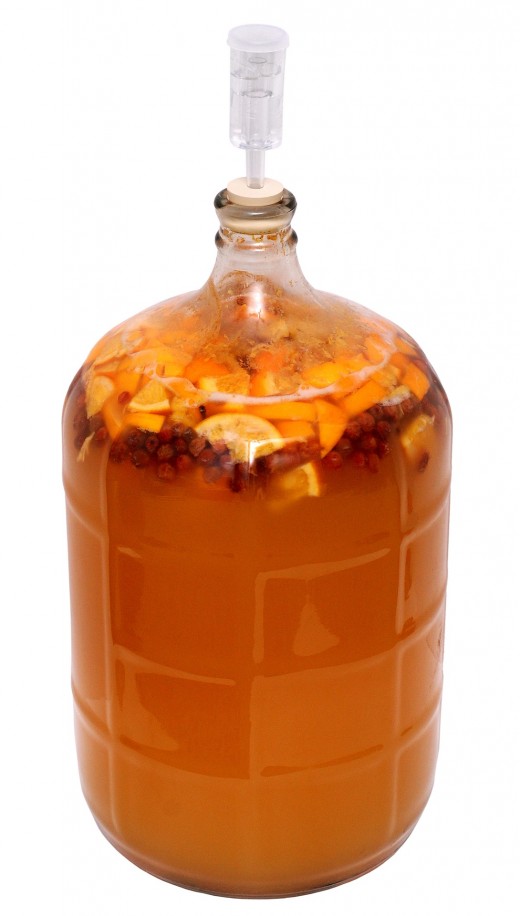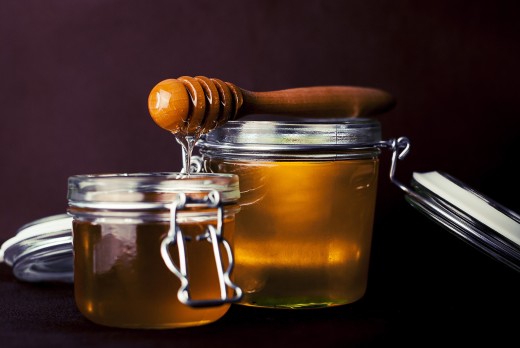How to Make Mead!
Mead fermenting

What is mead?
Mead is an alcoholic beverage made by fermenting honey and water. Occasionally other ingredients are added to it to give it some more flavour such as:
- fruits
- grain
- seeds
- hops
- malt
Mead, like cider is in a category of its own. It is akin to a white wine in the techniques and ingredients used to ferment it.
There are many different techniques for making mead and many different combinations of flavours can be achieved. The alcohol content of mead varies from about 8% up to about 20%.
Most meads take at least 4 weeks to ferment and take at least 6 months before they mature enough to be drinkable. A young mead is often not a nice tasting mead. Old father time is required for mead to become palatable. That being said I do have a recipe for a quick drink mead that will only take one month to mellow and taste nice (obviously if you leave it longer than a month it will taste even better).
Mead poll
Do you like the taste of mead?
The Bee is important for the making of honey

What does mead taste like?
This is a tricky question to answer as it depends on the mead.
The lower percentage meads tend to have a sweet, somewhat ale like taste to them. This can usually be attributed to the use of beer or ale yeast in the recipes that create these meads.
The 10%+ abv meads tend to have a sweet, white wine taste to them. The honey flavour is more distinctive and it tends to have a slightly sticky feel in the mouth. These meads tend to be more viscus than the lower strength meads. They have a lovely golden colour to them and go down a treat.
The 18% to 20% meads have a much thicker mouthfeel. They are very honey-like and warm the throat on the way down. They tend to have a darker golden colour to them and make very nice liquors.
The above are very general descriptions of the taste of mead. The type of honey can affect the taste, look and strength of the mead as can the techniques used to make them.
My advice is to try or make different types of meads to see which ones you prefer. Sample as many meads as you can.
A history of mead
What equipment do you need to make mead?
Mead is a fairly simple beverage to make and doesn't require a lot in regards to specialized equipment or ingredients. It can, however, be quite an expensive beverage to make as honey is the main ingredient and honey is not cheap. If you have a way of getting hold of large quantities of honey for cheap then you are on to a winner.
Primary Fermenter
The first piece of equipment you will need is a fermenting vessel. If you are a wine make then you probably have most of the required equipment at hand. If not some kind of fermenting vessel will be required. When starting out making mead it is a good idea to make small batches until you get the hang of it. You can pick up a 1-gallon demijohn for quite a cheap price of $5 or so, usually, they come with an airlock as well. This is another piece of equipment needed for mead making. Amazon and eBay are full of demijohns and airlocks so they are easy to get hold of. If you are lucky and live near a homebrew shop then you can pick up all of the gear you need from there. Shop around online.
The demijohn is basically a large glass/plastic jug that you will pour your ingredients into to ferment. The airlock is a funny-shaped device that you place on the demijohn that allows gas to escape the demijohn but prevents bugs and bacteria to enter the demijohn. Without an airlock, the carbon dioxide produced during fermentation would build up and build up until the demijohn exploded from the internal pressure.
If you do not want to fork out for a demijohn (also known as a carboy) or an airlock there is another option. That option is to pick up a 1-gallon bottle of water from your local supermarket. You can then use a condom, stretch it over the opening of the bottle, and poke a pinhole into it. The condom is a sterile item and will expand enough to safely let the carbon dioxide out. This is a super cheap way of doing it but is not 100% foolproof and can lead to your mead being contaminated. Many people have made wine using these pieces of equipment and have had no troubles with their brews, but many have tried it and contaminated their brews and ended up with horrible tasting vinegar drinks.
Whatever way you wish to do it cleanliness is super important. That brings us to the next piece of equipment.
Cleaning products
When making mead you need to make sure that all of the equipment that you use is clean and sanitary. Washing it with a bit of washing-up liquid is no good. You need to use chemicals that will kill any bacteria present in the equipment. There are lots of antibacterial sanitizers available to home brewers and they all have their benefits and constraints. You can find many of them available on Amazon or eBay, some you can even find in your local grocery store.
The front runner of the cleaning solutions, the one I hear most homebrewers use is Starsan. It sanitizes and sterilizes and is a rinse-free food-safe product. Using Starsan will not contaminate your brew or alter its flavor. There are various other cleaning products similar to Starsan all you have to do is a quick google search and you can find many alternatives.
Campden Tablets
These are very useful tablets that are used to sterilize your brew. It kills off any bacteria that may have gotten into the mead, on fruit, or other ingredients that you use. You pop on the Campden tablet into a gallon of your brew before adding the yeast. This kills off any wild bacteria thus giving your yeast a less hostile atmosphere to work in.
Siphon
A siphon is a piece of equipment that you will need in order to transfer your fermented mead into bottles. There are various different types of siphons available, some are more complex than others. The most basic siphon you can get is a rubber tube that you can use to move the contents of your demijohn into bottles. Some siphons come with filters attached to help filer out dead yeast and muck that form at the bottom of the demijohn. Some come with pumps and other such attachments that help to siphon out the liquid and leave behind the unwanted crud giving you a clearer, more aesthetically pleasing mead.
Bottles
Empty bottles are required for storing and pouring your mead. You can simply recycle wine bottles that you have to hand, so long as you clean them thoroughly. Alternatively, you can buy wine or mead bottles online or from your local homebrew store. Once your mead has fermented out and all the dead yeast has dropped to the bottom of the demijohn you siphon the mead into the bottles and store them for however long you need to before it is ready to drink.
Second demijohn (optional)
An optional extra is a second demijohn. This could be used for racking your mead. After the mead has finished fermenting and the bits have dropped to the bottom, you siphon the mead into a second demijohn. Then you leave it for a further few weeks until any remaining yeast and debris has settled to the bottom. Then you siphon the mead into bottles. This is a way of getting a much clearer mead. The clarity of mead is more to do with aesthetics than the actual taste. People prefer their mead to be crystal clear rather than cloudy.
How to bottle wine or mead
Ingredients needed
There are several ingredients that you will need to make a mead:
- Honey is the key ingredient to making mead. Choose your favorite type of honey
- Yeast. There are various different types of yeast available. Experiment with different ones to see what your preference is
- Yeast nutrient. This is essential for making mead as honey does not contain much in the way of nutrients. This means that without it your yeast will have a harder time making the mead and may die off too early.
Every other ingredient is optional and depends on taste.
Honey is important to the flavour of the mead

A basic mead recipe
What you need:
- 1 gallon demijohn
- 3lb
honey (any honey you choose)
- 1tsp/ 1 sachet of yeast (a universal wine yeast would be good to start with)
- 1tsp Yeast nutrient
What you do:
- Pour your honey into the demijohn. Swill some hot water about inside the honey bottle or jar to remove the last dregs of honey
- Top the demijohn up with hot water and swill the mixture about until all the honey has dissolved
- Pour in the yeast and the yeast nutrient
- Put the airlock on
- Leave in a warm dark place for 24 hours
- Check on the mead after 24 hours. If the airlock is bubbling that means that fermentation has begun
- Check on your mead weekly to see how far fermentation is
- Once the airlock has stopped bubbling fermentation is complete (basically the yeast has eaten all the sugar in the demijohn and has excreted all the alcohol it can)
- Leave the mead and check back every week to see if it has dropped. This means that all of the by products of fermentation have sunk to the bottom of the demijohn
- Here you can either siphon the mead into a second demijohn and wait for it to clear even more or you can simply bottle the mead
- The last step is to leave the mead to age. Leave it in a cool dry, dark place for 6 months. Taste a sample of the mead after 6 months. If it still needs time leave it a further month then repeat. Keep aging it for as long as it needs to become tasty.
- Finally drink it and enjoy








